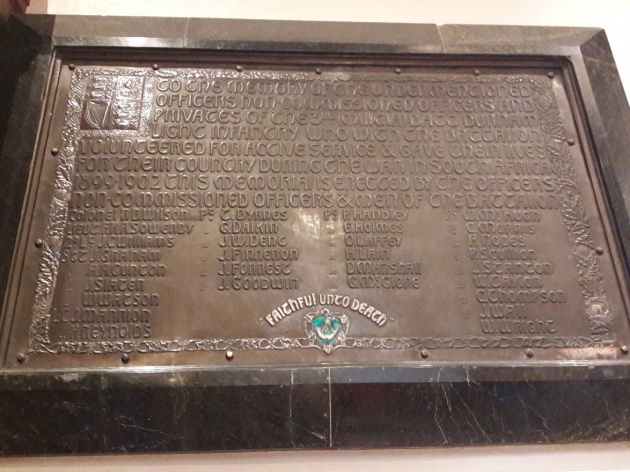South African War memorial
One of St Mary’s little observed ‘treasures’ is the ‘Arts and Crafts’ plaque which commemorates men of the 3rd Battalion Durham Light Infantry who died in the South African Wars 1899-1902.
Tucked in the south-west corner of St Mary’s on the south wall is the stunning copper regimental plaque, decorated with foliage and insignia and inscribed with the names of 30 officers, NCOs, and privates of the 3rd Battalion DLI who died in the South African wars, 1899-1902. With Colonel RB Wilson commanding, they had supplied over 800 men to active service and guarded Lines of Communication in Cape Colony and Orange Free State. They formed the first Militia Mounted Infantry Company and escorted convoys as well as garrisoning Dewetsdorp.
Barnard Castle had held a spontaneous torch-light procession to celebrate the end of this war and a town memorial was erected on Galgate, but for St Mary’s a very special regimental plaque was commissioned from Herbert Maryon, Director of the Keswick School of Industrial Arts, and was unveiled on 27th July 1904 by Col. Charles Freville Surtees.
Photo copyright: Newsquest Darlington & Stockton Times

Set on a surround of green Italian marble, from quarries near Genoa, the metalwork is in repoussé style – copper hammered from the reverse side to create a low-relief design – and incorporates insignia and symbols from local and county history:
On the left –
- The royal standard with lions passant and rampant
- The Vane coat of arms (Vanes of Raby Castle had commanded the Durham Militia and 3rd Battalion DLI)
- The shield of Co Durham: three left-handed gauntlets with a hand above.
- The Bowes coat of arms (John Bowes of Streatlam Castle commanded the Militia in the 1850s)

On the right –
- Saint Cuthbert’s cross
- The boar passant: the crest of Richard III, Lord of Barnard Castle
- The Durham Cathedral door-knocker, representing sanctuary
- The Town Seal of Barnard Castle – ‘Barnard Sigill communo Burgensium de Castro’
- The Dun Cow of Saint Cuthbert, as on the north-east corner of Durham Cathedral
At the bottom are the words: “Faithful unto death”, and the regimental badge in enamelled silver on a green ground: a bugle suspended by silver cords, with ‘3 DLI’ in the centre. The decoration around the frame reproduces the foliage of oak and ash trees, and ivy, illustrating words of the old Ballad of the North Country Maid:
“The oak, and the ash, and the bonny ivy tree,/They flourish at home, in my north country.”
Designer Herbert Maryon (1874 –1965) directed the award-winning Keswick School of Industrial Art before teaching at Reading and Durham Universities. A post-retirement career in archeology led to work for the British Museum and in 1956 his OBE for reconstructing the Sutton Hoo helmet.
